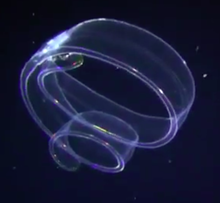| Venus girdle | |
|---|---|

| |
| Photographed in Hawaii | |
| Scientific classification | |
| Domain: | Eukaryota |
| Kingdom: | Animalia |
| Phylum: | Ctenophora |
| Class: | Tentaculata |
| Order: | Cestida |
| Family: | Cestidae |
| Genus: | Cestum Lesueur, 1813 |
| Species: | C. veneris |
| Binomial name | |
| Cestum veneris Lesueur, 1813 | |
The Venus girdle (Cestum veneris) is a comb jelly in the family Cestidae. It is the only member of its genus, Cestum, and is also the largest of all known ctenophores.
Description
Venus girdles resemble transparent ribbons with iridescent edges. They may grow up to a metre in total length. Canals run the length of the ribbon in which bioluminesce activates when disturbed.
Distribution
This species is pelagic and is found in tropical and subtropical oceans worldwide in midwater.
Ecology
These animals swim horizontally using muscular contractions as well as the beating of the comb rows. The oral edge leads. They eat small crustaceans.
References
- "WoRMS - World Register of Marine Species - Cestum veneris Lesueur, 1813". marinespecies.org. Retrieved 10 September 2013.
- ^ Wrobel D. & Mills C. 2003. Has no bell, no tentacles,found in the Mediterranean Sea. Pacific Coast Pelagic Invertebrates: a guide to the common gelatinous animals. Sea Challengers. ISBN 0-930118-23-5
| Taxon identifiers | |
|---|---|
| Cestum | |
| Cestum veneris |
|